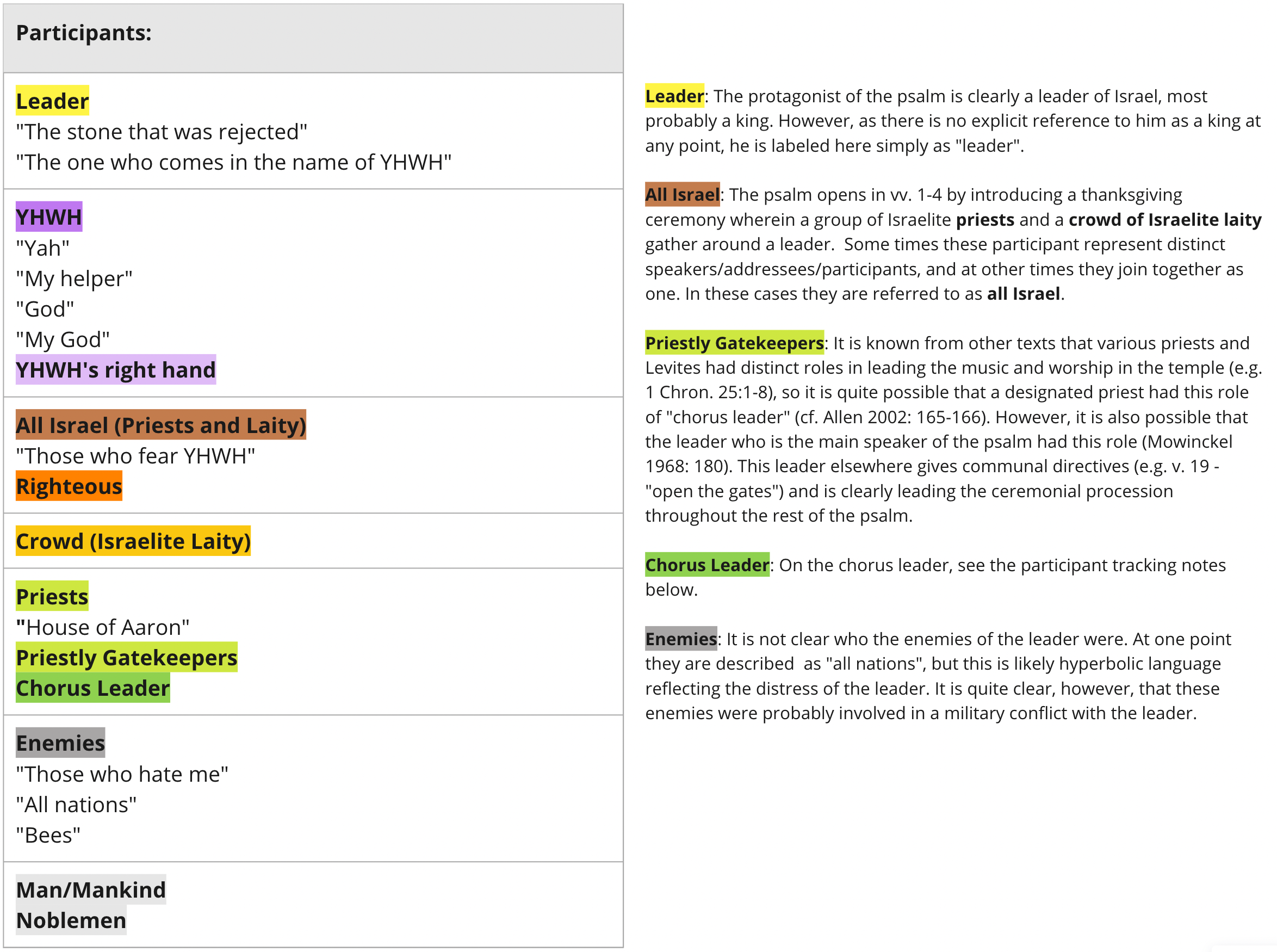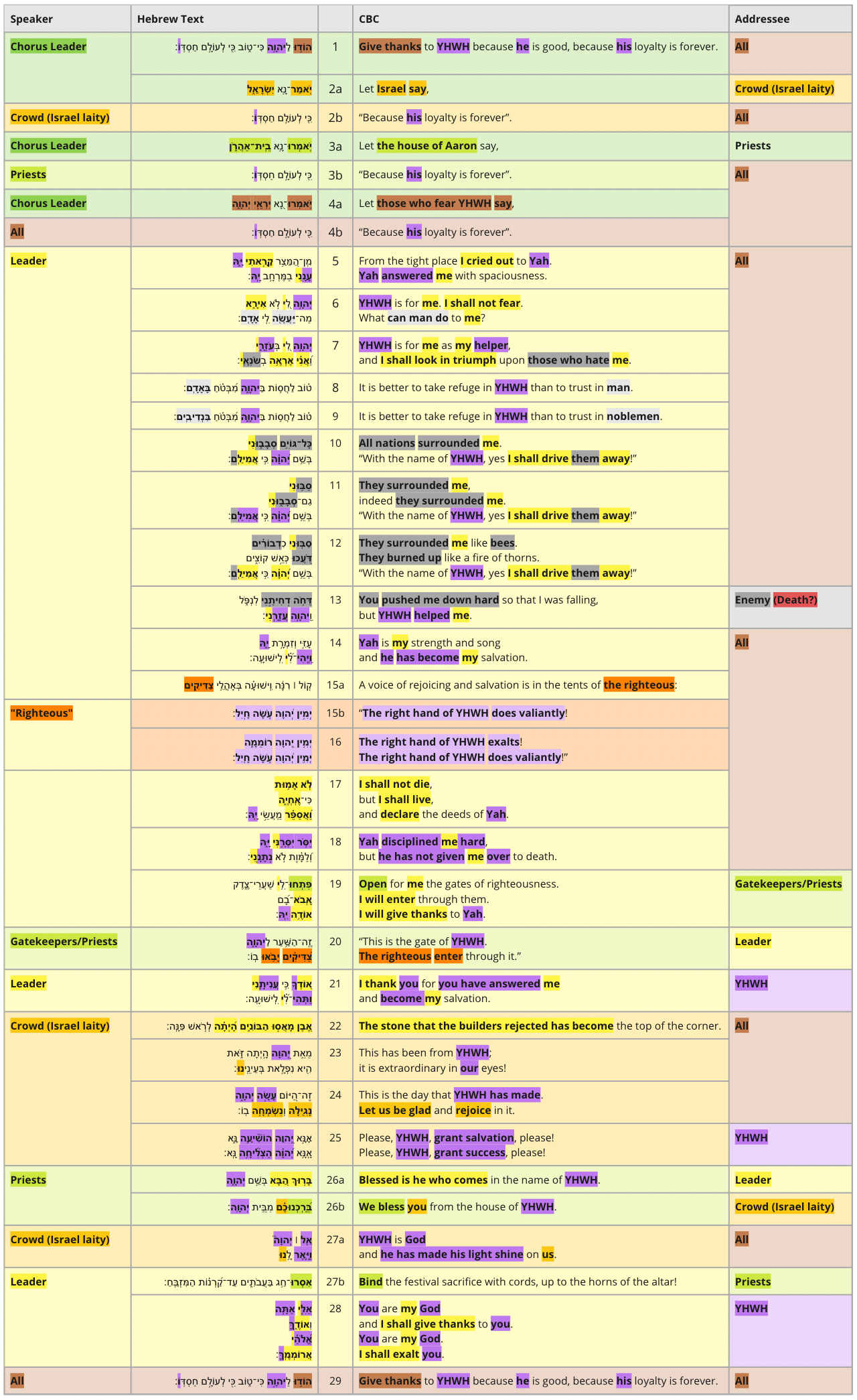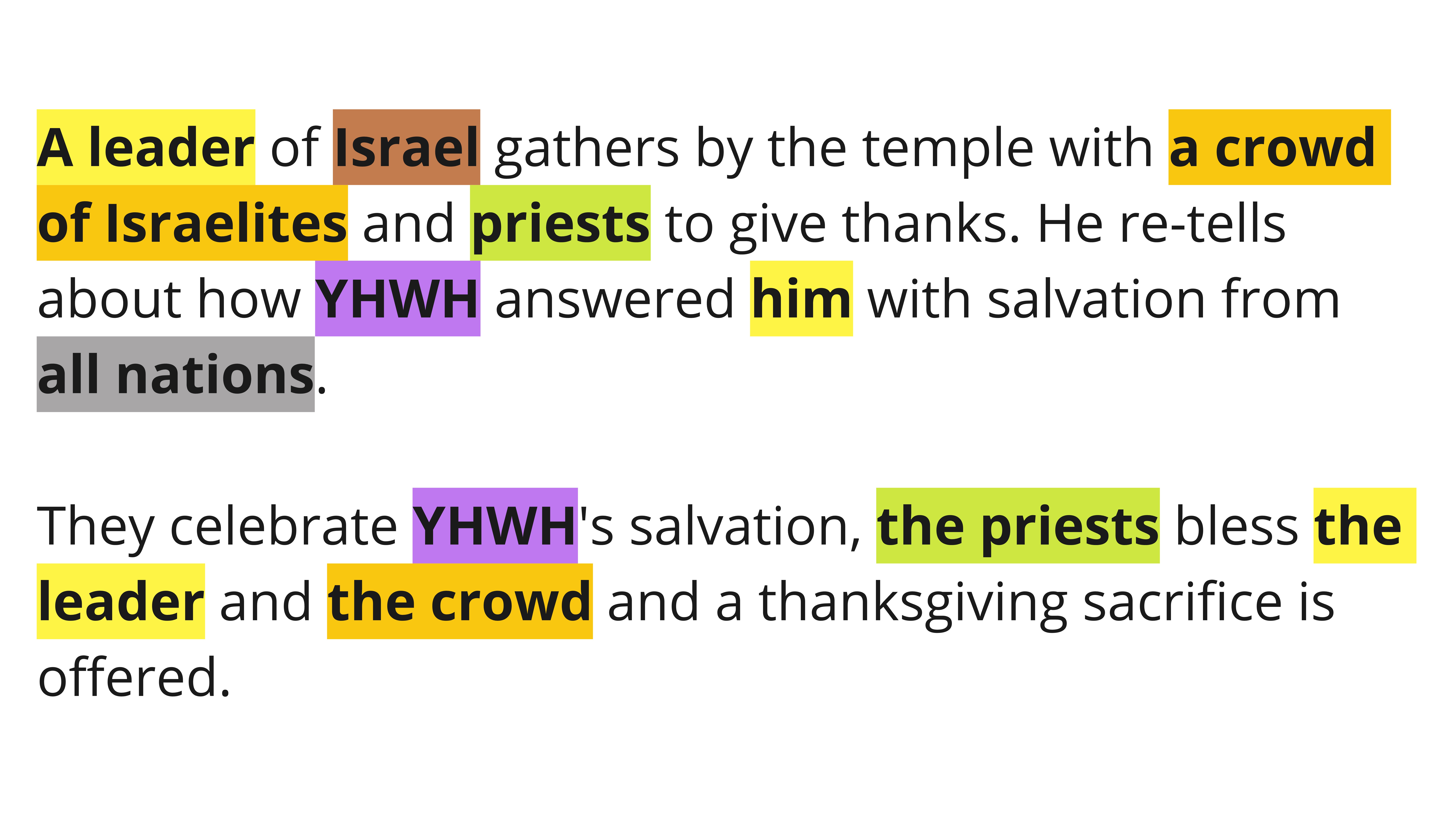Psalm 118 Discourse
From Psalms: Layer by Layer
Macrosyntax
Notes.
Coordination, Subordination, and Discourse Markers
- vv. 2, 3, 4 כִּי
- This is a causal כי subordinating the following clause to the ellided opening clause of the refrain (הודו לה׳). This is an antiphonal response wherein the activated parties echo the opening refrain by repeating only the final clause of it. The result is a dislocated "floating" subordinating particle.
- v. 7 - waw indicating result (BHRG §40.23.4.2.5)
- v. 10, 11, 12 כִּי - Asseverative כי (JM §164b)
- v. 11 גַם - Case of the relatively rare function of גם for "affirmation", repeating and strengthening the preceding clause ("They surrounded me, indeed/yes, they surrounded me") (BHRG §40.20.4).
- v. 13 - contrastive waw
- v. 14 - waw indicating addition
- v. 17 כִּי - Adversative כי expressing a counter-statement after a negative statement (BHRG §40.29.2.3). Functioning here as a contrastive coordinating conjunction.
- v. 17b - waw indicating sequence and outcome
- v. 18 - contrastive waw
- v. 21 - waw indicating addition
- v. 27 - waw indicating addition
- v. 28 - waw indicating result (BHRG §40.23.4.2.5)
Word Order:
- vv.1-4, 29 - marked focus
- to emphatically establish the duration of YHWH's loyalty
- v. 5a - poetic word-order variation to indicate new section of direct speech
- This pattern corresponds to verses like Ps 68:23 and Isa 40:3 where there is a parallelism in which the A-line has a prepositional phrase fronted. This is a poetically motivated variation in word order functioning to introduce a new section of direct speech.
- v. 7b - marked topic
- for topic shift
- v. 10a - thetic:
- opens a report in direct speech (BHRG §47.2.1.)
- "In a SF [thetic] sentence, the subject referent is not conceptualised as actively involved in some situation but as appearing on the 'scene' of the discourse (Lambrecht 2000: 623)
- v. 10b, 11c, 12c - marked focus
- establishing the means by which the enemies are driven away.
- Lunn (2006: 328) puts a question mark next to these clauses as to whether they are pragmatically marked, but בשׁם ה׳ is probably marked focus.
- v. 13b - marked topic
- contrastive topic shift
- v. 14a - marked focus
- informing about the features/characteristics of the active subject
- v. 18b - marked topic
- providing a restriction the extent to which "YHWH disciplined me" (v. 18a)
- v. 20b - sentence focus
- opening a report in direct speech about the righteous entering through the gate (BHRG §47.2.1a)
- v. 22 - sentence focus
- opening a report in direct speech
- v. 23a - predicate focus with marked constituent focus
- informing specification of source for the unexpected events described in v. 22
Vocatives:
- v. 25a - clause-initial vocative: identify addressee
- v. 25b - mirroring 25a
- v. 28c - It is possible to read the אֱ֝לֹהַ֗י here as a vocative (as in LBS Tu es mon Dieu, je te louerai, je t’exalterai, ô mon Dieu!). It is preferred, however, to read it as an elided nominal clause.
Paragraph Delimitation:
- 1-4 |5-9
- End of antiphonal call to praise with direct speech quotations of involved parties
- Beginning of new narrative with marked constituent focus
- 5-9 | 10-12
- New section introduced by sentence focus of 10a which begins new narrative report
- 10-12 | 13-18
- Shift in agent from report concerning third person plural subject (all nations) to second person singular subject (דַּחֹ֣ה דְחִיתַ֣נִי - you pushed me down hard).
- 13-18 | 19-21
- Shift in addressee introduced by second personal plural imperative asking the gatekeepers to open the gate.
- 19-21 | 22-25
- New section indicated by new speaker (made explicit by PP "בְּעֵינֵֽינוּ" in 23b)
- 22-25 | 26-27
- New section indicated by new speaker
- Note: The shift in speaker here is only indicated on a semantic level, wherein the priests in the gate respond to the crowd and the leader with a priestly blessing
- 26-27 | 28-29
- New section indicated by new speaker (made explicit by shift from first personal plural to first person singular, as seen in the PP [27b] and the possessive suffix [28a])
Other:
- Infinitival phrases in vv. 8-9 are nominalised and treated here simply as noun phrases
- Speakers in vv. 22-29:
- 22-25 - The crowd
- 26-27 - The priests (27 ambiguous - the crowd? the priests? both?)
- 28-29 - The leader (29 ambiguous)
- Interesting to note that despite very prevalent use of parallelism in this psalm there doesn't seem to be any poetically motivated variation in word order
Speech Act Analysis

For Visual, click "Expand" to the right
Notes:
- vv.19-21 - Gate-entrance Ceremony: These verses seem to reflect a kind of gate-entrance ceremony wherein the leader requests entrance to the gate and states his intention to give thanks to YHWH (v. 19), the gatekeepers (probably priests in the temple) grant entrance to the gate, using a declaration describing the characteristics of the gate and those who enter through it (v. 20), and the leader's response (v. 21).
Participant Analysis
There are several participants/characters in Psalm 118:
Text Table
Tracking Table
Participant Relations
Summary Visual
The relationships among the participants may be abstracted and summarised as follows:








